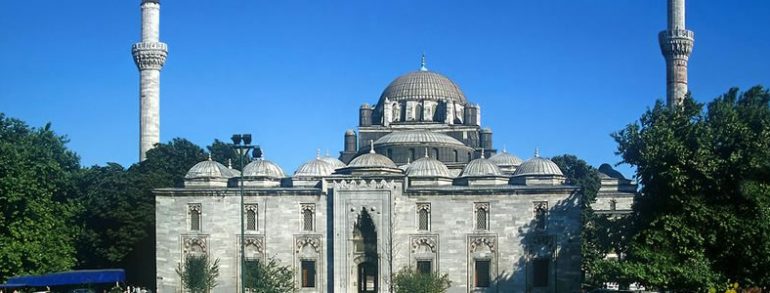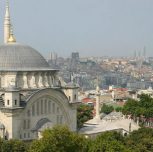The Bayezit Complex, built by Sultan Bayezid II (1451-1512), was constructed disorganizedly in the town in 1505, and it gives its name to the area in which it is situated. It consists of a mosque, a madrasah (religious school), a Turkish bath, a caravanserai, a hostel (tabhane), and a primary school (sıbyan mektebi). Although the architect of the complex is unknown, it is thought that the structure was built by the architect Hayretttin or th earchitect Kemaleddin. According to research recently conducted concerning the complex, it is claimed that it was built by Yakupşah bin Sultanşah.
The mosque, being the main structure of the complex, is a major element of the site and is like an open air museum in which Ottoman architectural works are displayed. The inner courtyard, with its marble covered floor, is surrounded by domed cloisters and opens into the main praying room. The inscription of the mosque on the portal gate with its “celi sulus” calligraphy belong to the Calligrapher Hattat Şeyh Hamdullah which reveals that it was built between the years 1500-1505.
It has a square plan with a dome of 16.87m in diameter, and the weight of its dome, which crowns the ceiling structure of the mosque, is placed on four columns. The ceiling structure of the Harim (sanctum sanctorum) is also composed of the two half-domes supporting the main dome. In addition, the mosque was later extended, adding annexes to both of its sides. These annexes both are covered by four domes each. As for that the Royal Lodge (Hünkar Mahfili), it is supported by ten marble columns and is placed under the last dome showing the direction of qibla toward Mecca. It contains the serial domes located on the right-hand side. In addition to the royal lodge where the muqarnas and decorative workmanship attract the attention of visitors, exceptional stone workmanship on the pulpit, niche, and respondent platform (müezzin mahfili) has affected the aesthetic view of the structure. At the beginning of its construction, the winglike overhangs on both sides of the mosque’s entrance were designed as hostels (tabhane), but afterwards the wall located between the hostels and the mosque was removed and the hostels were included in the mosque area. Since the decorative minarets of the mosque were placed at the tip of the hostels, there is a distance of 17 meters between the two minarets. One of which, located on the right side and repaired in 1954, protected its original ornaments to a great extent. The other one, located on the left side, is thought to have been restored in an unknown date. It is more simple when compared to the one located on the right side.
The soup kitchen and caravanserai are located on the left of the mosque and are used today by the Beyazit State Library. In addition, the madrasah located in the Bayezit Square, in the direction of Laleli district, is used as a museum by the Turkish Foundation of Calligraphy. The hamam (Turkish Bath) of the complex, which is known as Patrona Halil Bath, located near Istanbul University Letter Faculty , has recently been broadly restored by Istanbul University.










